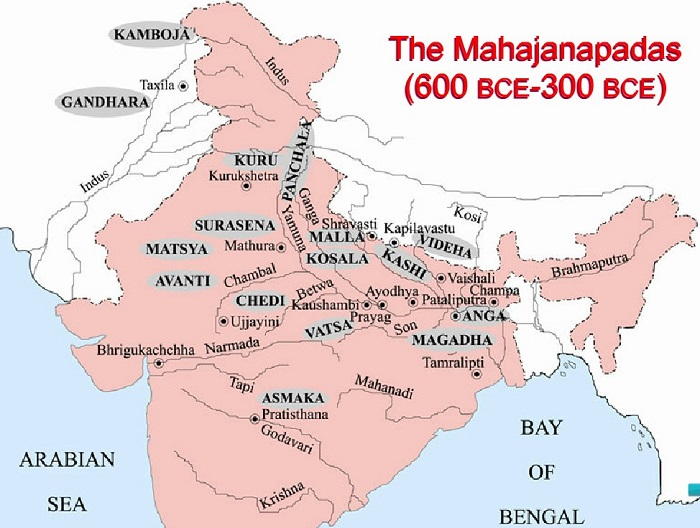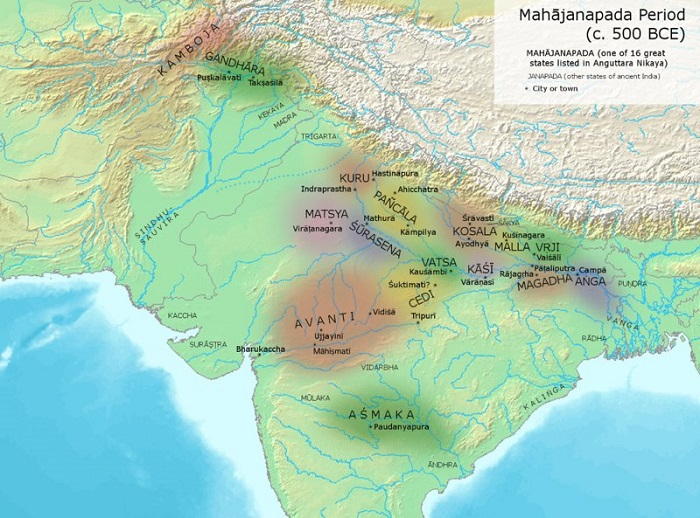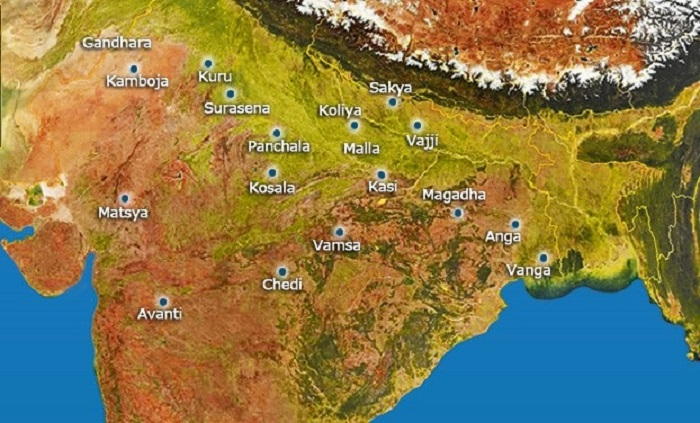Fast Facts
Era: Iron Age
Period: 6th – 4th centuries BCE
Type of Government: Republics & Monarchies
Languages: The Prakrits & Sanskrit
Religion: Vedic Hinduism
The Mahajanapadas were a set of sixteen kingdoms that existed in ancient India. It all began when the tribes (janas) of the late Vedic period decided to form their own territorial communities, which eventually gave rise to new and permanent areas of settlements called ‘states’ or ‘janapadas.’ In the sixth century BC, present-day Bihar and eastern Uttar Pradesh became centers of political activities as the region was not only fertile but also closer to the iron production centers. Iron production played a crucial role in expanding the territorial states of the region. These expansions helped some of these ‘janapadas’ turn into large states or ‘mahajanapadas.’ Most of these ‘mahajanapadas’ were monarchical in nature, while some of them were democratic states. Many prominent ancient Buddhist texts make frequent references to the ‘16 great kingdoms’ (mahajanapadas) that flourished between the sixth and the fourth centuries BCE. These 16 kingdoms included kingdoms like Anga, Gandhara, Kuru, and Panchala, which are mentioned in the great Indian epic ‘Mahabharata.’
History of the Mahajanapadas
In order to settle down permanently, simple land-grabbing process was started by the tribes, which eventually turned into well-planned communities. These communities gave rise to states or ‘janapadas’ and tribal identity became a major factor in defining the territory of a particular state. Gradually, some of these states began to expand and hence came to be known as the ‘mahajanapadas.’ Since expansion involved annexing of neighboring states, certain ‘mahajanapadas’ started conquering other ‘janapadas’ in order to extend their kingdoms as per the kingdom’s prosperity and wealth.
Early stages of settlement of the tribes happened before the time of the Buddha. Hence, historical references of these ‘mahajanapadas’ can be found in ancient Buddhist texts. Many such texts talk about ‘16 great kingdoms’ that flourished between the sixth and the fourth centuries BCE. The period between the sixth and fourth centuries BCE is considered extremely important in early Indian history as it witnessed the emergence of massive Indian cities, which were built after the fall of the Indus Valley Civilization. These massive Indian cities were home to the 16 great kingdoms described in the ancient texts. In the modern era the term ‘mahajanapadas’ is often used to refer the 16 great kingdoms, which are mentioned below.

Image Credit : http://www.gkexperts.in/quiz-based-on-mahajanapada-period/
List of Mahajanapadas
Magadha
Magadha was one of the most prosperous kingdoms of ancient India and one of the most prominent ‘mahajanapadas.’ For many years, Pataliputra was the capital of Magadha. The kingdom was bounded by Ganges in the north, river Champa in the east, and river Son in the west. According to ancient texts, Brihadratha was the earliest known ruler of Magadha. The kingdom was also ruled by King Bimbisara, under whom Magadha flourished. Great Indian empires including the famous Maurya Dynasty originated in Magadha. Gautama Buddha spent much of his life in Magadha, hence the region is believed to hold great significance to Buddhists.
Gandhara
According to Hecataeus of Miletus, Purushapura or present-day Peshawar served as a grand Gandharic city. Other references pertaining to Gandhara have been made in ancient texts like ‘Rigveda,’ ‘Ramayana,’ and ‘Mahabharata.’ This great kingdom was served graciously by river Indus and its capital Taksashila (Taxila) housed the renowned center of learning, the ‘Taksashila University.’ Scholars came to the university from all over the world in order to seek greater knowledge and wisdom. Though Gandhara was a huge kingdom on its own, it is often considered to be a part of an empire by modern-day scholars. Dr. T. L. Shah even argued that Gandhara and Kamboja, which was one of the 16 ‘mahajanapadas,’ were two provinces of a single empire.
Kamboja
The state of Kamboja is referred to as republican in several ancient scripts. These scripts also state that there were two Kamboja settlements, a theory which is backed by modern-day historians. It is said that ancient Kamboja was located on either sides of the Hindukush mountain range. But clans of Kamboja are believed to have crossed the mountain range to plant colonies in the southern side as well. These clans of people are associated with the Gandharas and Daradas and find mention in many Indian texts, including the edicts of Ashoka the Great.
Kuru
At the time of the Budhha, Kuru was ruled by Korayvya, a titular chieftain. Its capital was Indraprastha (present-day Delhi), which was known for people with sound health and deep wisdom. The Kurus were related to people of other communities like the ‘Panchalas’ and the ‘Yadavas’ as they had matrimonial relations with them. Though Kuru kingdom was a well-known monarchical state in the ancient world, the 6th and 5th centuries BCE saw the formation of republican form of government in the land of Kuru. Kautiliya’s ‘Arthashastra,’ which was written in Sanskrit in the 4th century BCE, also states that the Kurus followed the king consul constitution.
Kosala
The kingdom of Kosala was located close to the kingdom of Magadha. With Ayodhya as its capital, Kosala was bound by river Ganges in the south, river Gandak in the east, and the Himalaya mountains in the north. According to Vedic texts, Kosala was the biggest and most powerful kingdom ever in history. At the time of the Buddha and Mahavira, Kosala kingdom was ruled by King Prasenajit. After a series of tactical moves for supremacy by Kosala and Magadha, the kingdom of Kosala was eventually merged with Magadha, when Kosala was being ruled by Vidudabha.
Malla
The Mallas of the Malla kingdom are often described as powerful people who dwelled in Northern South Asia. Many Buddhist texts refer to the kingdom as a republican dominion made up of nine territories. Like Kuru, Malla kingdom too had monarchical forms of government, but later moved towards the republican form of government. Ancient cities like Kusinara and Pava, which belonged to the Malla kingdom, are considered extremely important by Jains and Buddhists. While Lord Mahavira had his last meal at Kusinara, Gauthama Buddha had his last meal at Pava. Both Kusinara and Pava are believed to have hosted Buddha for a long period of time.
Panchala
The Panchala kingdom was located east of the Kuru kingdom, between river Ganges and the mountain ranges of the Himalayas. Panchala was divided into two parts, namely Dakshina-Panchala and Uttara-Panchala. While Adhichhatra (present-day Bareilly) served as the capital city of Uttara-Panchala, Kampilya (present-day Farrukhabad) was made the capital of Dakshina-Panchala. Originally a monarchical kingdom, Panchala is believed to have turned into a republican dominion during the 6th and 5th centuries BCE. Kautiliya’s ‘Arthashastra’ also states that Panchala followed the king consul constitution. The kingdom was later annexed by Mauryan Empire and then by the Gupta Empire.
Matsya
Located south to the Kuru kingdom and west to river Yamuna, the Matsya kingdom was founded by an Indo-Aryan tribe of Vedic age. Apart from serving as the main water source, Yamuna also separated Matsya kingdom from the Panchalas. Viratanagara (present-day Bairat), which was named after the kingdom’s founder Virata, was Matsya’s capital. According to ancient texts, a king named Sujata ruled over Matsya as well as Chedi, which later became a separate kingdom. Though Matsya is mentioned as one of the ‘mahajanapadas’ in various Buddhist texts, its political power had greatly dwindled by the time of the Buddha.
Chedi
The kingdom of Chedi finds great prominence in the Hindu epic Mahabharata. According to the ancient text, Chedi was ruled by a king named Shishupala, who was an ally of the kings from Magadha and Kuru. A city named Suktimati has been described as the kingdom’s capital. Though the exact location of modern-day Suktimati has not been figured out yet, prominent historians like F. E. Pargiter and Hem Chandra Raychaudhuri say that the ancient city might have been established near present-day Banda in Uttar Pradesh. An Indian archaeologist named Dilip Kumar Chakrabarti has claimed that the ruins of a historical city near the outskirts of Rewa in Madhya Pradesh may unlock further details pertaining to the kingdom and its capital city.

Image Credit : https://en.wikipedia.org/wiki/Vajji
Anga
The earliest references to the people of Anga are made in the ‘Atharva Veda,’ which describes the Angas as despised people. The ‘Jaina Prajnapana’ claims that Angas were among the earliest groups of Aryan people. Over a period of time, the kingdom of Anga became a great center of trade, attracting merchants from the neighboring kingdoms. Anga and its rival Magadha were separated by river Champa, which served as the main water source for both the kingdoms. Anga was eventually annexed by Magadha in King Bimbisara’s one and only conquest.
Avanti
Post Mahavira and Buddha, the kingdom of Avanti was considered as one of the four great monarchies along with Kosala, Magadha, and Vatsa. Apart from serving as the kingdom’s principal source of water, river Narmada also separated Avanti into two parts – North Avanti and South Avanti. However, North and South Avanti were integrated at the time of Buddha and Mahavira, during which Ujjaini served as the common capital of the integrated kingdom. Avanti was a great center of Buddhism. When King Shishunaga defeated Nandivardhana, Avanti became a part of Magadha.
Vatsa
Vatsa or Vamsa, which was located near the present-day Allahabad in Uttar Pradesh, thrived under a monarchical form of government. King Udayana of the 7th century BCE ruled Vatsa with Kausambi as its capital. Though Udayana initially opposed the teachings of the Buddha, he became a follower of Buddha later in his life and even made Buddhism as the state religion of Kausambi. Vatsa’s capital city attracted a number of wealthy merchants, who made Kausambi their home. Kausambi was also a prominent entreport of passengers and goods, coming in from the south and north-west.
Assaka
The Kingdom of Assaka was located in southern India. Apart from serving as the kingdom’s principal source of water, river Godavari separated Assaka from Mulaka, which was also known as Alaka. It is said that Mulaka was once a part of Assaka. According to Buddhist texts, King Brahmadatta ruled over Assaka with its capital at Potali (present-day Maharashtra). Assaka is described as one of the 16 ‘mahajanapadas’ in an ancient Buddhist text known as ‘Anguttara Nikaya.’
Surasena
The kingdom of Surasena was located to the west of river Yamuna and to the east of Matsya kingdom. Surasena played an important role in propagating Buddhism as the king of Surasena, Avantiputra, was among the earliest known chief disciples of Buddha. During the time of Megasthenes, Mathura, the capital of Surasena, was known as a city where worshipping Krishna was considered prominent. The kingdom of Surasena, which once flourished, was later annexed by the Magadhan Empire.

Image Credit : https://odrageneralknowledgeonindianhistory.blogspot.com/2016/10/life-in-age-of-janapadas-and.html
Vajji
Vajji was one of the most prominent ‘mahajanapadas’ of ancient India. Vajji finds mention in the Jaina text ‘Bhagavati Sutra’ and in Buddhist texts like ‘Anguttara Nikaya.’ Vajji was located towards the north of the river Ganges and was bound by river Gandaki in the west. Apart from serving as Vajji’s chief source of water, river Gandaki is believed to have played a key role in separating Vajji from Malla and Kosala as well. Apart from Vaishali, which was its capital city, Vajji also housed popular ancient cities like Hatthigama, Bhoganagara, and Kundapura.
Kashi
Ancient Kashi was bound by river Varuna in the north and river Assi in the south. The Kingdom of Kashi, which had its capital at Varanasi, was the most powerful among ‘mahajanapadas’ before the time of the Buddha. Several ancient texts speak highly of Kashi, which was one of the most prosperous kingdoms during its heyday. Hence, Kashi was in constant conflict with kingdoms of Kosala, Magadha, and Anga, which were trying to annex Kashi. Though Kosala was once defeated by Kashi, it was later annexed by Kosala under the rule of King Kansa, who ruled at the time of Buddha.


